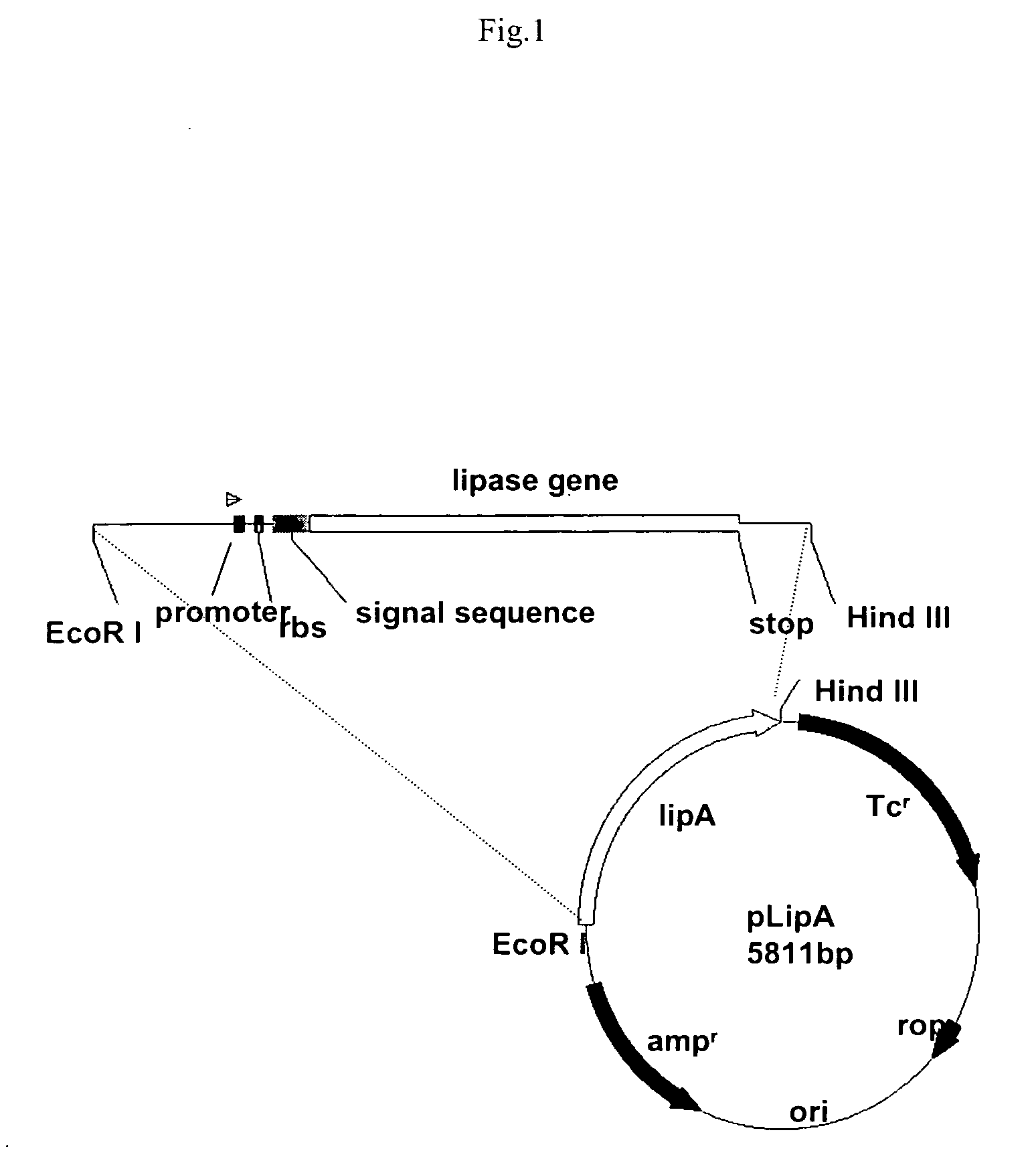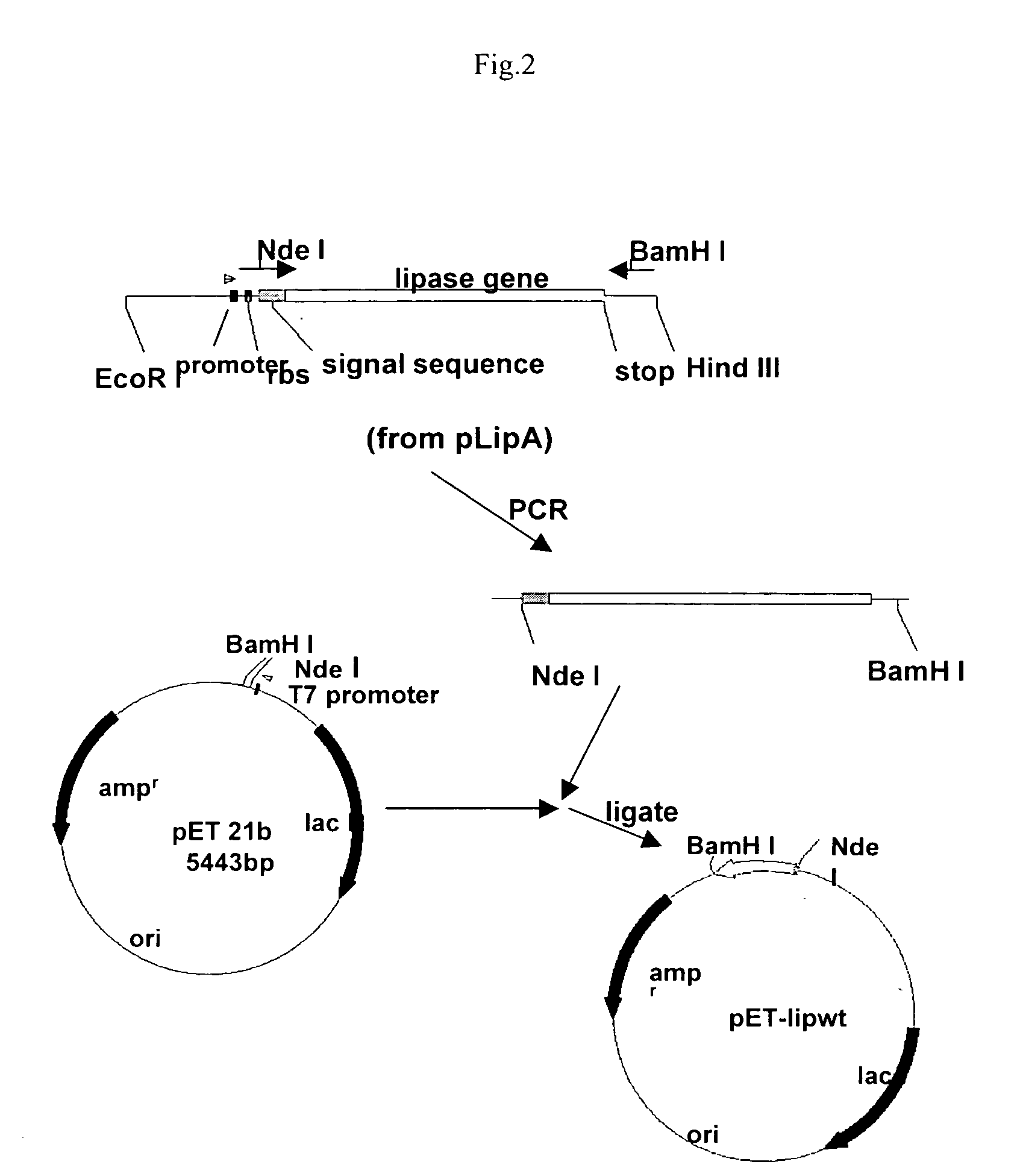Stable gene variants of lipases
- Summary
- Abstract
- Description
- Claims
- Application Information
AI Technical Summary
Benefits of technology
Problems solved by technology
Method used
Image
Examples
example 1
Purification of Lipase from Bacillus subtilis
[0061] Purification of the lipase was performed from E. coli cells expressing the lipase in an appropriate vector. The purification essentially involves passing the cell lysate in phenyl-sepharose column followed by a Mono-S column. Lipase is an aggregated prone protein, care especially keeping protein concentration below 5 mg / ml, was taken to avoid aggregation of the protein. The purification of the lipase was carried out essentially as described earlier with minor modifications. Lipase from culture filterates of Bacillus strain or from the E. coli lysates was processed similarly. For purification of the wild type and mutant proteins from E. coli the lipA gene or the mutant genes are cloned into pET 21b). For this, the gene corresponding to the full length, mature protein was amplified with primers PrNde I (forward primer) (5′-CCATGATTACGCATATGGCTGAACACAA-3′) and JOF. The forward primer had an engineered Nde I site. The forward primer ...
example 2
Assay of Lipase:
[0063] Lipase belongs to a class of enzymes known as interfacially active enzymes. These enzymes have very little activity on the substrate monomers but their activity increases dramatically on insoluble substrate such as emulsified triglycerides, monolayers etc. This property makes lipases dissimilar to other enzymes which act on soluble substrate monomers. Triglycerides, natural substrates of lipase are not very convenient to set up simple chromogenic assays. Activity of pure lipases, sometimes, can be monitored by detecting the pH changes using pH-sensitive dyes. However, such assays yield complications when the enzyme source is a lysate and when there are other processes that may alter the pH. P-nitrophenyl esters are most convenient to monitor the activity. Short chain ester, p-nitrophenyl acetate and long chain ester, p-nitrophenyl oleate (PNPO), were synthesized by routine synthetic methods (given below). PNPO is a insoluble ester, was used in our assays usi...
example 3
[0069] Lipase assay in 96-well microtitre plates): The colonies obtained from the cloning of the PCR product generated by error-prone PCR were patched on another similar plate and simultaneously inoculated in separate wells of a microtitre plate containing 200 μl 2XYT containing 25 μg / ml chloramphenicol and 0.2% glucose. The cells were grown for 24 hours in the microtitre plate with continuous shaking at 200 rpm. After 24 hrs, 5 μl culture from each well was taken and added to the corresponding well another microtitre plate containing 200 μl 2XYT supplemented with 25 μg / ml chloramphenicol. After 3 hours of growth the cultures were induced with 1 mM IPTG. After 3 more hours 25 μl of culture was taken from every well into the corresponding wells of two fresh microtitre plates containing 25 μl phosphate buffer pH 7.0. One of the plates was exposed to high temperature for 20 min, cooled on ice for 15 min and then allowed to come to room temperature. The other plate was kept at room temp...
PUM
| Property | Measurement | Unit |
|---|---|---|
| Temperature | aaaaa | aaaaa |
| Temperature | aaaaa | aaaaa |
| Fraction | aaaaa | aaaaa |
Abstract
Description
Claims
Application Information
 Login to View More
Login to View More - R&D
- Intellectual Property
- Life Sciences
- Materials
- Tech Scout
- Unparalleled Data Quality
- Higher Quality Content
- 60% Fewer Hallucinations
Browse by: Latest US Patents, China's latest patents, Technical Efficacy Thesaurus, Application Domain, Technology Topic, Popular Technical Reports.
© 2025 PatSnap. All rights reserved.Legal|Privacy policy|Modern Slavery Act Transparency Statement|Sitemap|About US| Contact US: help@patsnap.com



